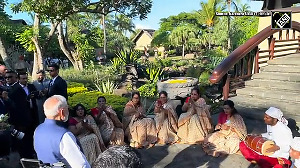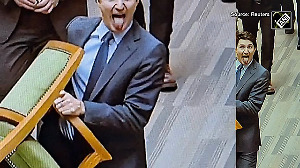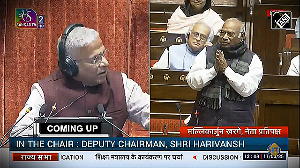Prime suspect in the 1985 Air India bombing Talwinder Singh Parmar had reportedly told Punjab Police that leaders of a Sikh youth organisation might be behind the attack that claimed 329 lives, according to evidence presented to a public inquiry on Monday.
He reportedly told his interrogators that leaders of International Sikh Youth Federation might play a role in the plot.
But Mark Freiman, chief counsel to the inquiry commission, has cautioned against drawing any 'hasty conclusions' from the evidence.
The Air India inquiry presided over by Justice John Major heard from two men with the Punjab Human Rights Organisation, who testified that Parmar was captured in Jammu in September 1992 and then interrogated before he died.
There was no testimony of how Parmar 'died.'
Both Sarabjit Singh and Rajvinder Singh Bains explained that their group was approached about the Parmar evidence after two men were acquitted in Vancouver in March 2005.
Entered as evidence was a statement, purportedly given by Parmar, in which he appears to deflect responsibility for the Air India and Narita bombings on June 23, 1985 by suggesting the whole idea came from ISYF leader Lakhbir Singh Brar.
"He asked some help from me, doing these intense activities. After conferring with him for some time, I agreed to help," a translation of Parmar's alleged confession made by Bains said.
"He wanted to show the anger of the Sikhs to the whole world by doing some powerful explosions and to establish our recognition," the translation of Parmar's alleged confession says.
"Parmer said that Brar brought one Reyat to him about four days later and I was ready and the same three went in the car to the forest."
The statement appears to be referring to the June 4, 1985 test blast, conducted by Parmar and Reyat near Duncan with a mystery man police have dubbed Mr X. Parmar claims that the third man is actually Brar, who now lives in exile in Pakistan after being deported from Canada.
He is the nephew of slain militant leader Jarnail Singh Bhindranwale.
Brar's associates in the ISYF earlier told the Vancouver Sun that they did not believe he could have been involved in the plot, which appeared to have been underway long before Brar arrived in Canada.
The judge leading the Air India inquiry has suggested the twisted, chaotic investigation into the deadly June 1985 bombing might have been better off had the Canadian Security Intelligence Service not been created.
Expressing concerns about inter-agency conflicts and the spy agency's reluctance to turn over raw intelligence data to the Royal Canadian Mounted Police or British Columbia Crown attorney's office, justice John Major last week asked a former senior CSIS official whether 'a lot of this scurrying around' could have been avoided.
"At this stage, it doesn't look as if the creation of CSIS was a step forward," Major suggested to Chris Scowen, a former senior CSIS counter-terrorism official.
Scowen disagreed. He had earlier outlined how Parliament intended when it created CSIS in July 1984, a year before the Air India disaster, to draw a line between the agency's role as an 'intrusive' intelligence gathering agency and the RCMP's role to investigate crimes and gather 'evidence.'
"I understand the problems," Major said, adding, "But it seems to me that the transition came at a bad time. You have this act of terrorism, which destroys 331 people's lives and CSIS and the RCMP appear to be at odds over what can be provided to whom on what basis."
Scowen and another CSIS official clearly indicated on Sunday the same legal conflicts that plagued the Air India bombing investigation.
Jack Hooper, who retired last May as CSIS deputy director of operations, said CSIS is 'religious' about the need to protect the identities of agents, sources, and details of its sophisticated surveillance techniques in order to retain its credibility and long-term ability to detect national security threats.







 © 2025
© 2025